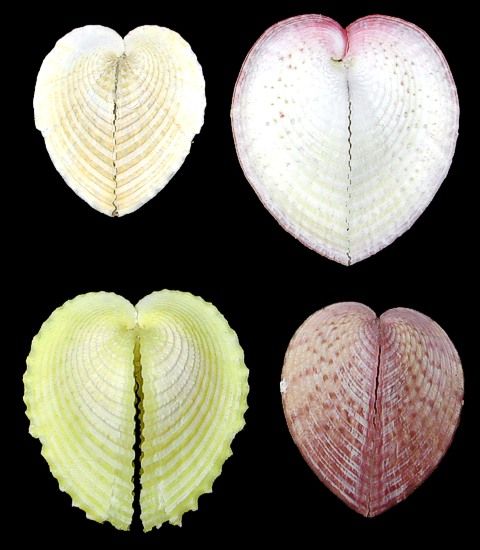One heart cockle Shells, natural color (mostly white to cream color) measuring 1 to 2.25 inches *****
One Cardium Cardissas (Heart cockle Shell) natural color (mostly white to cream color) measuring 1 to 2.25 inches.
Orders usually process within 2 to 5 business days.
Email us at ja1@mindspring.com Make Your Selections and Shipping Preference. We Will Email You the amount of the Shipping Cost. When you receive the shipping cost go back into Shells of Aquarius and click into Purchase Shipping Label. There you will find UPS or USPS. Click into the option you decided on and make your payment. Your order will ship when shipping payment is received.
t.
Corculum cardissa
common name the heart cockle, is a species of marine bivalve mollusk in the family Cardiidae. They are found in the Indo-Pacific region.
bivalve, (class Bivalvia), any of more than 15,000 species of clams, oysters, mussels, scallops, and other members of the phylum Mollusca characterized by a shell that is divided from front to back into left and right valves. The valves are connected to one another at a hinge.
The two valves of Corculum cardissa are unequal in size and often asymmetric. Their shape varies, when viewed from above, the outline is roughly heart shaped which gives the mollusks their common name. Viewed from the side the shape bears a resemblance to the shell of a cockle. In some specimens the posterior valve is nearly flat or has a slight hump. In others it is more rounded.
The boundary of the valves is usually flat but is sometimes somewhat sinuous. Smaller shells tend to be elongated; larger shells are more rounded and the growth rings can be seen clearly. The shell is thin and translucent, particularly the upper side. There is an intricate mosaic pattern of more and less transparent white regions. The lower valve has a mainly white surface with a few transparent regions. The gills and mantle, especially the lower siphon, are dark brown owing to the presence of microscopic algae. The outer surface of the mantle also contains granules of reddish, purple and blue pigment.
Sinuous means having many curves, bends, turns or winding.
Corculum cardissa is often found lying on a surface of sand among coral debris and broken shells. They usually lye horizontally in a hollow it excavates and its top is often covered with filamentous algae and muddy deposits.
filamentous A fine or very thin thread or fiber: filaments of cloth; filaments of flax.
Corculum cardissa is a filter feeder. The shell gapes slightly at the ventral end and two siphons are protruded. Water is drawn in through one and expelled through the other and plankton and detritus are extracted. At the same time, water passes over the gills where oxygen is absorbed.
Corculum cardissa is a hermaphrodite. Eggs are laid and the larvae develop with great rapidity. Within 24 hours of fertilisation, the veliger larvae have been observed to develop two valves and be swimming on the surface of the substrate. A day later, they had undergone metamorphosis and had settled on the bottom as juveniles, miniature versions of the adult bivalves.
A hermaphrodite is a sexually reproducing organism that produces both male and female gametes.[1] Animal species in which individuals are of different sexes, either male or female but not both, are gonochoric, which is the opposite of hermaphroditic.
Scientific classification
Domain: Eukaryota
Kingdom: Animalia
Phylum: Mollusca
Class: Bivalvia
Order: Cardiida
Family: Cardiidae
Genus: Corculum
Species: Corculum cardissa
Binomial name: Corculum cardissa
(Linnaeus, 1758)
(REF: Corculum cardissa (Linnaeus, 1758) World Register of Marine Species. )(REF: Kawaguti, Siro. "Observations on the heart shell, Corculum cardissa (L.), and its associated Zooxanthellae" (PDF). Pacific Science. 4)(REF: Farmer, MA; Fitt, WK; Trench, RK (2001). "Morphology of the Symbiosis Between Corculum cardissa (Mollusca: Bivalvia) and Symbiodinium corculorum (Dinophyceae)". Biological Bulletin. 200 )(REF: Avise JC (2011-03-18). Hermaphroditism: A Primer on the Biology, Ecology, and Evolution of Dual Sexuality. Columbia University Press)(REF: Leopold, Luna B., Wolman, M.G., and Miller, J.P., 1964, Fluvial Processes in Geomorphology, San Francisco, W.H. Freeman and Co.)
